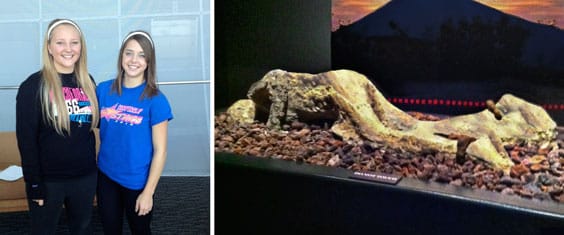RCHS students spend a day in ancient Pompeii

Shannon McFarland and Joslin Lichty pause between exhibits at the Denver Museum of Science and Nature.
(Photo courtesy of Shannon McFarland)
The body casts of Pompeii’s victims left a big impression on the students.
(Photo courtesy of Caty Guiffre)
By Lisa Nicklanovich; courtesy photos
To learn about volcanoes, earth, and environment and space (EES), students at Rock Canyon High School (RCHS) experienced “A Day in Pompeii” at the Denver Museum of Nature and Science. EES students were transported to ancient Pompeii before, during, and after the eruption of Mount Vesuvius in 79 AD, which buried the Roman city beneath thick layers of volcanic ash.
Students viewed a video re-creating the city’s bustling trade and commerce prior to the eruption and toured typical homes rich with mosaic tile pools and colorful frescoes. A digital re-creation depicted the final 24 hours of Pompeii, giving students an appreciation of the power and scale of Mt. Vesuvius’ destruction. Then, with study packets in hand, students explored the artifacts, including room-size frescoes, marble and bronze sculptures, jewelry, gold coins, cooking and medical utensils, even casts of the volcano’s victims frozen in their last moments. EES teacher Jessica Muniz said, “I believe strongly in students experiencing what we are learning about; how else will they be as excited as I am about the past, present, and future of science?” This rang true for student Caty Guiffre, who said, “I loved being able to see the casts of the bodies; it made the horribleness of the tragedy come alive for me.”
In addition to the Pompeii exhibit, students traveled through the solar system, taking in the wonders of the planets and moons in the planetarium’s “Cosmic Journey: A Solar System Adventure.” The museum also features a Gems and Minerals Hall, a Space Odyssey, a Prehistoric Journey, and a Wildlife Adventure. Most students enjoyed the specimens and hands-on activities of all four. It seems the Pompeii exhibit left the biggest impression on one student who noted, “I learned Mount Vesuvius experiences a Plinian eruption approximately every 2,000 years. That means it’s due to erupt again!”